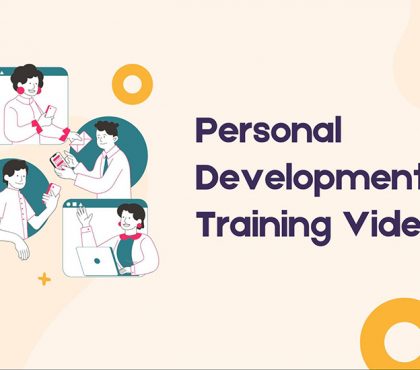Training videos are the best way we know so far to tackle the shortening attention span. This approach to workplace training excels at breaking down complicated, dull, or abstract concepts into more digestible chunks of information. It captures the audience’s attention to immersively deliver the knowledge. The problem is, there are just so many types of training videos to choose from. Choosing a suitable video type depends on your audience’s goals, your budget, available resources, or in some cases, just personal preference.
But for a start, F.Learning Studio will guide you through 8 of the most common types of training videos and when each outshines the others. Let’s take a look!
#1 Instructor-led Training Videos
This is one of the most common types of training videos you can find in online programs. Instructor-led training videos feature an instructor delivering the information to the camera. However, this method itself is not that engaging. The instructor needs to combine other materials like images, screencasts, or presentations to boost the effectiveness of the training video.
It’s important that instructor-led training videos are concise. Providing information in short bursts allows learners to acquire knowledge straight away. It saves valuable and productive time as well as avoids things that will get too distracting for the audience. A longer video takes more time to be digested and eventually applied.
When To Use: Instructor-led videos are most applicable when you have an engaging, expert presenter to showcase.
Pro Tips: Always keep your instructor-led videos short, about 10 minutes max. Should the videos be longer, learners may lose interest. Focus on the core concepts to deliver concise and clear information. You can recycle old materials to create more microlearning-friendly content.
Recommend reading:
#2 Animated Training Videos
Animated training videos come in all shapes and sizes. We have stop-motion, whiteboard animation, explainer, 3D, kinetic text and video, and moving infographics, just to name a few. These are training videos that utilize fully animated visuals to illustrate the content. They are great for explaining ideas, data, and complex processes.
When To Use: Animated training videos excel at explaining complex processes and ideas (popular in onboarding situations). They can illustrate concepts that are invisible or challenging to imagine, as shown in the example below.
Example: Permaculture Design – Animation For First-year Students
Permaculture Design Online Course is a 12-week program that provides practical solutions to develop sustainable ecosystems. The idea was to engage online learners and promote positive changes. However, the course contains some confusing and intangible concepts, such as the formation of metamorphic rocks. F.Learning Studio creatively uses 2D animation to illustrate various processes that occur to lay the knowledge process down quickly and clearly.
Recommend reading:
- Animation vs Live action: Which works better for your projects?
- 2D vs 3D animation: What should you choose for your projects?
#3 Simulation Training Videos
Simulation training videos, or scenario-based training videos, use real-world situations to educate learners. The audience will experience relatable scenarios that they can brainstorm viable solutions for. Unlike other types of training videos, simulation training programs are specific. This type of training video showcases exactly how one should handle a certain situation. For example, what to do when faced with a dissatisfied customer, a system error, or co-worker conflict.
When To Use: Simulation training videos are best for experiential learning. It showcases how the knowledge should be applied or how employees are supposed to deal with difficult situations.
Example: Sole Trader Business – Business Laws Animation
Law courses contain countless abstract concepts that can be heavy, intensive, even dull, and boring. To engage learners and boost the training program’s proficiency, F.Learning Studio decided to change the delivery. We illustrate the business laws with visual metaphors to make the theories less intimidating. The video also incorporated daily situations to demonstrate how learners should apply what they have learned in real life.
#4 How-To Training Videos
How-to training videos, also known as demonstration videos, demonstrate a task or guide the learner through a process. They are popular on YouTube, where the instructor often showcases the exact process in their videos. When the audience attempts to replicate that process in their own experience, it triggers learning. From there, learners acquire the information they need, like “how to cut an onion” or “how to bake cookies.”
When To Use: Take advantage of how-to training videos to demonstrate step-by-step processes and guide the learners.
#5 Interactive Training Videos
Interactive training videos incorporate interactive elements to allow the learners to lead their storylines and involve themselves in the experience. The interactive elements can be quizzes (short assessments at the end of the video), 360 views (all-direction viewing), or in-person communicative lectures.
Interactive training videos are time-intensive to create. However, they are by far one of the most engaging types of training videos providing learners to explore the end of their choices.
When To Use: Use interactive videos as often as possible. They can be incorporated into different types of training videos to create a more immersive experience. If time and budget permit, interactive videos can be the most effective tool to facilitate human learning. However, they also cost the most resources to build.
Recommend reading:
#6 Presenter Training Videos
Presenter training videos involve someone speaking directly to the audience through the camera. However, unlike instructor-led training videos, this type doesn’t require illustration to be effective. Presenter training videos work best when you want to showcase the presenter’s skills and knowledge. Another benefit of a presenter video is that it takes little to produce. The presenter can easily turn a regular training session into a video with a camera.
When To Use: Businesses can go for presenter training videos when there’s a personable and credible presenter in-house. This method also allows the organizations to create training content from available resources.
#7 HSE Training Videos
Health, Safety, and Environment (or HSE for short) training videos employ a systematic approach to address aspects of workplace safety. They raise help raise awareness about possible threats to the health and well-being of employees. Apart from the general topics, HSE training videos should also deal with company-specific safety practices. This includes workplace safety overviews, facility accident statistics, or the most common types of injuries regarding a certain job.
When To Use: HSE training videos can be used to educate employees about workplace safety in compliance with safety training regulations.
Example: Intelycare – Fire Safety Training
IntelyCare wants to provide the very basics of fire safety knowledge to the audience. The animation illustrates the hazard in a precise situation without putting anyone at risk in real life. The video showcases the dangerous consequences of a fire and demonstrates what learners can do to minimize the risks.
#8 Screencast Training Videos
Screencast training videos are screen recordings of training content that are most popular with software tutorials and demos. The videos capture the actual software on-screen and typically use a voiceover narration to guide the learner to complete a set of tasks. Hundreds of large-scale software companies have utilized this type of training video to help their customers understand how to use their software.
When To Use: Screencast training videos are most effective for software tutorials or technical process instructions.
Conclusion
When it comes to different types of training videos, your choices are bountiful. From a simple screencast recording to beautifully designed animated videos, feel free to explore the option to find the one that best fits your goals. Keep on integrating videos into future training programs to make your employees’ development more entertaining, engaging, effective. In case you need an expert’s opinion on how to incorporate animation into training, give us a call. F.Learning Studio is here 24/7 to answer your inquiries.
You May Also Like:
- 12 training video production companies you shouldn’t miss (2021 updated)
- How to use animation in training and elearning
- 11 best examples of animated training videos

Sean Bui, the founder and creative director of F.Learning Studio, is a respected leader in the e-learning and multimedia production industry. With over 10 years of experience, he has dedicated his career to helping organizations create engaging and impactful learning experiences.
Under his leadership, F.Learning Studio has grown into a trusted partner for organizations in the education, healthcare, and corporate training sectors, producing over 2,000 minutes of educational animation.






